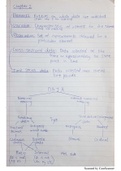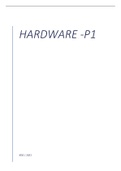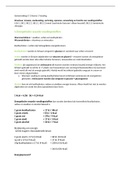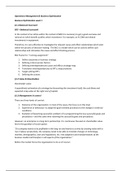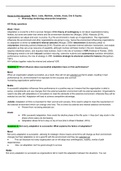Mandatory articles Globalization & Offshoring (G&O)
Week 1 Week 2
Article Page Article Page
1.1 – Ghemawat, 2007 2 2.1 – Berry et al., 2010 8
1.2 – Altman & Bastian, 2020 3 2.2 – Shenkar, 2012 10
1.3 – Cuervo-Cazurra et al., 2020 5 2.3 – Zaheer et al., 2012 12
2.4 – Ghemawat, 2007 14
Week 3 Week 4
Article Page Article Page
3.1 – Luo et al., 2013 18 4.1 – Manning et al., 2010 26
3.2 – Mihalache & Mihalache, 2016 21 4.2 – Nieto & Rodríguez, 2011 29
3.3 – Søderberg et al., 2013 24 4.3 – Sartor & Beamish, 2014 31
Week 5
Article Page
5.1 – Lu & Beamish, 2004 34
5.2 – Graafland & Noorderhaven, 2020 36
5.3 – Pegoraro et al., 2021 38
5.4 – Ghemawat, 2007 41
,1.1 – Ghemawat, 2007
Why the world isn’t flat?
1. What is the main idea of the article?
→ Abstract – Introduction – Conclusion– 3/4 sentences
The main idea of Ghemawat (2007) is that the world is only a fraction as integrated as we thought it is.
The levels of internationalization are not as high as you should expect with a fully globalized world.
2. What is the context and goal of this study?
→ Assumptions
It is an ‘answer’ to papers from globalists like Thomas L. Friedman that argue that the world is
increasingly wired, informed, and thus highly globalized and ‘flat’.
3. Type of research and methodology
→ Type of research: conceptual/empirical/literature review
→ Methodology
Conceptual paper.
4. What are the takeaways?
It sounds compelling, but Friedman’s assertions are simple the latest in a series of exaggerated visions.
However, Ghemawat argues that the world is not nearly as connected as these writers have us believe.
Despite the fact that money, people, ideas can move faster than ever before, it is just a fraction of
what globalization would look like if the world is ‘flat’.
The few cities that dominate international financial activity (Frankfurt, Hong Kong, London, New York)
are at the height of modern global integration, but most statistics reveal that most types of economic
activity that could be conducted either within or across borders turns out to still be quite domestically
concentrated. More than 90% of all FDI is still domestic. Other variables associated with cross-border
migration (e.g., cross-border migration, telephone calls) are also much closer to 10%. The biggest
exception (in absolute terms) is the trade-to-GPD ratio which is around 20%. This data suggest a semi-
globalized world.
Barriers at borders have declined significantly (e.g., an international phone call is cheaper; the Internet)
but have not disappeared. People across the world may be getting more connected, but they are not
connecting with each other. The average South Korean user is probably chatting with friends rather
than meeting someone in Los Angeles.
Some dimensions (e.g., integration) reached their all-time high many years ago, some have only done
that recently, after long periods of stagnation and reversal (e.g., FDI stocks divided by GDP).
Since voters currently have the tendency to support more protectionism, the road for cross-border
integration (even if it would be on an upward path) is unlikely to be either smooth or straight. There
will be shocks and cycles, and maybe even another period of stagnation or reversal.
5. What are the implications?
The champions of globalization are describing a world that doesn’t exist. Governments that buy into
the flat world are likely to pay too much attention to the ‘golden straitjacket’ (Friedman). It is not only
unproductive, but also dangerous.
2
,1.2 – Altman & Bastian, 2020
How Globalized Is the World?
(Section 2: pages 11-26)
1. What is the main idea of the article?
→ Abstract – Introduction – Conclusion– 3/4 sentences
The main idea of Altman and Bastian (2020) is that this article is about the DHL Global Connectedness
Index. Section 2 is about how globalized the world actually is. The index is on track to decline in 2020,
but only one with an unprecedented collapse is people flow. Trade and capital flows have already
started to recover. This means that globalization appears to have weathered the COVID-19 stress test
surprisingly well. This index confirms Ghemawat’s assessment that the world is (and will remain) only
partially globalized.
2. What is the context and goal of this study?
→ Assumptions
The DHL Global Connectedness Index measures globalization based on trade, capital, information and
people flows. This is measured by the depth and breadth of international flows. The depth is how much
of the given activity is international rather than domestic (e.g., for trade they compare exports to total
economic output). The breadth is the geographic distribution of international flows.
3. Type of research and methodology
→ Type of research: conceptual/empirical/literature review
→ Methodology
Empirical.
4. What are the takeaways?
COVID-19 has impacted all four flows but has not led to a collapse of globalization.
3
, To maintain a balanced perspective on the state of globalization, the authors have considered three
distinct phases: 2001-2007 (strong pre-crisis growth), 2007-2009 (global financial crisis) and 2009-2019
(volatile and uneven recovery).
- 2001-2007: after a recession-related dip at the beginning of the millennium, global
connectedness increased steadily. Countries focused on opening markets and attracting
foreign investment. The growth of the internet expanded international information flows.
- 2007-2009: the global financial crisis caused a domino-effect with capital flows to plummet
first, followed by trade. Information and people continued to rise.
- 2009-2019: slow and volatile increase in the index. Protectionist trade policies outnumbered
liberalizing policies. In 2016, Brexit and the election of Trump started a new wave of turbulence
for globalization. in 2018, a trade war was underway between the US and China and by the
end of 2019, the WTO’s Appellate Body (to decide on disputes) lacked a majority. The trade
war has caused observed to worry that US-China decoupling could split the world economy
into rival spheres. China has already become less reliant on the US market before the trade
war and recent frictions have accelerated that trend.
- Long-run historical perspective: globalization has not advanced as swiftly/steadily since before
the global financial crisis but was close to an all-time record high level of connectedness just
before COVID-19. Globalization can go in reverse (as was the case between the 1920’s and
1950’s), but that is not likely.
Confirming Ghemawat’s 2007-paper, data shows that most business and personal activity is still
domestic rather than international. Roughly 21% of all goods and services end up in a different country
from where they were produced. However, ‘we’ think that these international flows are larger than
they really are. More than half of every international flow covered in this analysis happened between
countries and just their top-10 partners.
5. What are the implications?
The index confirms Ghemawat’s assessment that the world is (and will remain) only partially
globalized, also after COVID-19.
4
Week 1 Week 2
Article Page Article Page
1.1 – Ghemawat, 2007 2 2.1 – Berry et al., 2010 8
1.2 – Altman & Bastian, 2020 3 2.2 – Shenkar, 2012 10
1.3 – Cuervo-Cazurra et al., 2020 5 2.3 – Zaheer et al., 2012 12
2.4 – Ghemawat, 2007 14
Week 3 Week 4
Article Page Article Page
3.1 – Luo et al., 2013 18 4.1 – Manning et al., 2010 26
3.2 – Mihalache & Mihalache, 2016 21 4.2 – Nieto & Rodríguez, 2011 29
3.3 – Søderberg et al., 2013 24 4.3 – Sartor & Beamish, 2014 31
Week 5
Article Page
5.1 – Lu & Beamish, 2004 34
5.2 – Graafland & Noorderhaven, 2020 36
5.3 – Pegoraro et al., 2021 38
5.4 – Ghemawat, 2007 41
,1.1 – Ghemawat, 2007
Why the world isn’t flat?
1. What is the main idea of the article?
→ Abstract – Introduction – Conclusion– 3/4 sentences
The main idea of Ghemawat (2007) is that the world is only a fraction as integrated as we thought it is.
The levels of internationalization are not as high as you should expect with a fully globalized world.
2. What is the context and goal of this study?
→ Assumptions
It is an ‘answer’ to papers from globalists like Thomas L. Friedman that argue that the world is
increasingly wired, informed, and thus highly globalized and ‘flat’.
3. Type of research and methodology
→ Type of research: conceptual/empirical/literature review
→ Methodology
Conceptual paper.
4. What are the takeaways?
It sounds compelling, but Friedman’s assertions are simple the latest in a series of exaggerated visions.
However, Ghemawat argues that the world is not nearly as connected as these writers have us believe.
Despite the fact that money, people, ideas can move faster than ever before, it is just a fraction of
what globalization would look like if the world is ‘flat’.
The few cities that dominate international financial activity (Frankfurt, Hong Kong, London, New York)
are at the height of modern global integration, but most statistics reveal that most types of economic
activity that could be conducted either within or across borders turns out to still be quite domestically
concentrated. More than 90% of all FDI is still domestic. Other variables associated with cross-border
migration (e.g., cross-border migration, telephone calls) are also much closer to 10%. The biggest
exception (in absolute terms) is the trade-to-GPD ratio which is around 20%. This data suggest a semi-
globalized world.
Barriers at borders have declined significantly (e.g., an international phone call is cheaper; the Internet)
but have not disappeared. People across the world may be getting more connected, but they are not
connecting with each other. The average South Korean user is probably chatting with friends rather
than meeting someone in Los Angeles.
Some dimensions (e.g., integration) reached their all-time high many years ago, some have only done
that recently, after long periods of stagnation and reversal (e.g., FDI stocks divided by GDP).
Since voters currently have the tendency to support more protectionism, the road for cross-border
integration (even if it would be on an upward path) is unlikely to be either smooth or straight. There
will be shocks and cycles, and maybe even another period of stagnation or reversal.
5. What are the implications?
The champions of globalization are describing a world that doesn’t exist. Governments that buy into
the flat world are likely to pay too much attention to the ‘golden straitjacket’ (Friedman). It is not only
unproductive, but also dangerous.
2
,1.2 – Altman & Bastian, 2020
How Globalized Is the World?
(Section 2: pages 11-26)
1. What is the main idea of the article?
→ Abstract – Introduction – Conclusion– 3/4 sentences
The main idea of Altman and Bastian (2020) is that this article is about the DHL Global Connectedness
Index. Section 2 is about how globalized the world actually is. The index is on track to decline in 2020,
but only one with an unprecedented collapse is people flow. Trade and capital flows have already
started to recover. This means that globalization appears to have weathered the COVID-19 stress test
surprisingly well. This index confirms Ghemawat’s assessment that the world is (and will remain) only
partially globalized.
2. What is the context and goal of this study?
→ Assumptions
The DHL Global Connectedness Index measures globalization based on trade, capital, information and
people flows. This is measured by the depth and breadth of international flows. The depth is how much
of the given activity is international rather than domestic (e.g., for trade they compare exports to total
economic output). The breadth is the geographic distribution of international flows.
3. Type of research and methodology
→ Type of research: conceptual/empirical/literature review
→ Methodology
Empirical.
4. What are the takeaways?
COVID-19 has impacted all four flows but has not led to a collapse of globalization.
3
, To maintain a balanced perspective on the state of globalization, the authors have considered three
distinct phases: 2001-2007 (strong pre-crisis growth), 2007-2009 (global financial crisis) and 2009-2019
(volatile and uneven recovery).
- 2001-2007: after a recession-related dip at the beginning of the millennium, global
connectedness increased steadily. Countries focused on opening markets and attracting
foreign investment. The growth of the internet expanded international information flows.
- 2007-2009: the global financial crisis caused a domino-effect with capital flows to plummet
first, followed by trade. Information and people continued to rise.
- 2009-2019: slow and volatile increase in the index. Protectionist trade policies outnumbered
liberalizing policies. In 2016, Brexit and the election of Trump started a new wave of turbulence
for globalization. in 2018, a trade war was underway between the US and China and by the
end of 2019, the WTO’s Appellate Body (to decide on disputes) lacked a majority. The trade
war has caused observed to worry that US-China decoupling could split the world economy
into rival spheres. China has already become less reliant on the US market before the trade
war and recent frictions have accelerated that trend.
- Long-run historical perspective: globalization has not advanced as swiftly/steadily since before
the global financial crisis but was close to an all-time record high level of connectedness just
before COVID-19. Globalization can go in reverse (as was the case between the 1920’s and
1950’s), but that is not likely.
Confirming Ghemawat’s 2007-paper, data shows that most business and personal activity is still
domestic rather than international. Roughly 21% of all goods and services end up in a different country
from where they were produced. However, ‘we’ think that these international flows are larger than
they really are. More than half of every international flow covered in this analysis happened between
countries and just their top-10 partners.
5. What are the implications?
The index confirms Ghemawat’s assessment that the world is (and will remain) only partially
globalized, also after COVID-19.
4

